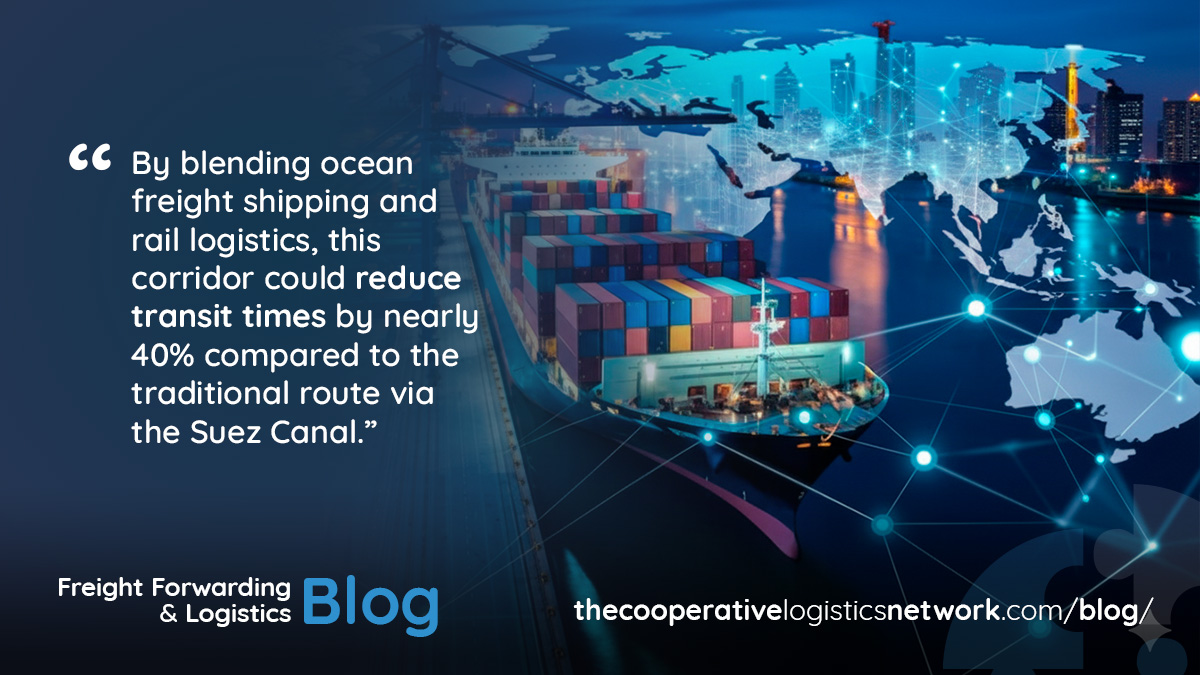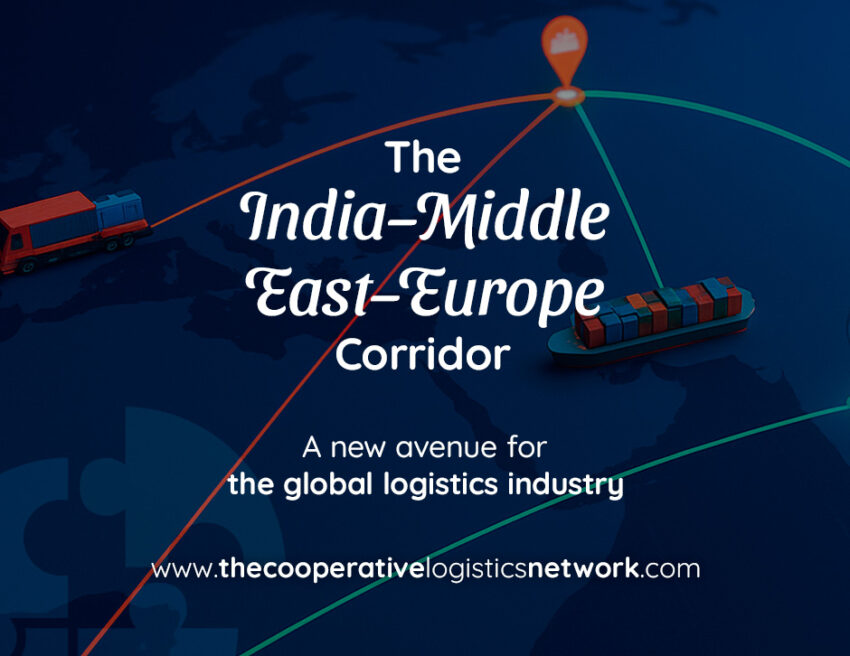The logistics industry stands on the brink of transformation with the unveiling of the India–Middle East–Europe Corridor (IMEC), a visionary multimodal transport project announced during the 2023 G20 Summit. Designed to enhance connectivity between India, the Middle East, and Europe, this corridor aims to redefine global trade by offering a faster, more reliable, and sustainable alternative to existing routes.
As the world gears up for shifting trade dynamics, the IMEC represents a strategic link between continents that could reshape ocean freight shipping, road freight, and container shipping operations for years to come. For freight forwarders, especially those in Asia, the Gulf, and southern Europe, it brings exciting opportunities to expand routes, strengthen partnerships, and gain a competitive edge in international logistics.

What Is the India–Middle East–Europe Corridor?
The India–Middle East–Europe Corridor (IMEC) is a proposed multimodal trade route connecting India with Europe through the Middle East, combining sea, rail, and road transport networks. It consists of two main legs:
-
The Eastern Corridor connects India’s western ports to the Arabian Gulf by sea.
-
The Northern Corridor links the Gulf to Europe via rail and road connections through Saudi Arabia, Jordan, and Israel.
From India’s Mundra and Nhava Sheva (JNPT), goods will be shipped by sea to UAE’s Jebel Ali, transported by rail across Saudi Arabia, through Jordan and Israel’s Haifa Port, and then shipped again across the Mediterranean to European destinations such as Piraeus (Greece) and Trieste (Italy). By blending ocean freight shipping and rail logistics, this corridor could reduce transit times by nearly 40% compared to the traditional route via the Suez Canal, while lowering costs and carbon emissions.
Why this corridor matters for freight forwarders
For freight forwarders, efficiency, speed, and cost control are at the heart of competitiveness. The India–Middle East–Europe Corridor is being designed with these priorities in mind. It offers a shorter, safer, and more predictable trade route that connects three of the world’s most dynamic regions.
Here’s how forwarders stand to benefit:
-
Faster transit and delivery: By avoiding congested maritime chokepoints, the corridor will offer faster alternatives for high-value and time-sensitive cargo.
-
Diversified transport options: Combining container shipping, rail, and road freight allows forwarders to provide more flexible and cost-effective multimodal solutions.
-
Increased resilience: Reduced dependency on traditional bottlenecks like the Suez Canal enhances supply chain reliability.
-
New freight routes: Forwarders can tap into emerging logistics markets in the Gulf and southern Europe, forging new trade partnerships.
For Indian freight forwarders, the IMEC could significantly boost export logistics, connecting industrial hubs to European buyers through shorter, greener supply chains. Forwarders in the UAE, Saudi Arabia, Jordan, and Israel will be strategically positioned as essential transit operators. Meanwhile, European forwarders in Italy, Greece, and beyond will benefit from faster import flows, reduced ocean freight congestion, and improved access to Asian markets.
Key ports and transit points along the India–Middle East–Europe Corridor
At the core of the IMEC’s success lies an interconnected network of major ports and inland hubs. Each of these locations will play a crucial role in facilitating trade across continents:
-
Mundra and Nhava Sheva (India): Among the busiest ports in South Asia, handling diverse cargo such as manufactured goods, textiles, chemicals, and machinery.
-
Jebel Ali (UAE): A global logistics powerhouse and the largest port in the Middle East, serving as a primary maritime gateway for the corridor.
-
Dammam and Riyadh (Saudi Arabia): Strategic hubs linking sea freight from the Gulf to the rail network extending toward Jordan and Israel.
-
Haifa (Israel): The Mediterranean endpoint of the rail corridor, connecting to ocean freight routes bound for southern and central Europe.
-
Piraeus (Greece) and Trieste (Italy): Two of Europe’s key logistics gateways, ensuring smooth cargo distribution into the EU and beyond.
Together, these ports form the logistical backbone of the India–Middle East–Europe Corridor, seamlessly blending container shipping, road freight, and rail connectivity to create one of the most efficient multimodal systems ever envisioned.
Types of cargo expected to move through IMEC
The India–Middle East–Europe Corridor is poised to handle a wide spectrum of cargo, supporting industries from manufacturing to renewable energy.
-
Consumer and Retail Goods: Shorter transit times mean Indian textiles, electronics, and household goods can reach European shelves faster.
-
Industrial Machinery and Automotive Parts: Increased connectivity will improve the flow of industrial components between India and Europe’s manufacturing hubs.
-
Energy Cargo: Oil, gas, and renewable energy components will move more efficiently, supporting regional energy trade.
-
Perishable Goods: The route’s multimodal design will benefit temperature-controlled cargo such as pharmaceuticals, food, and flowers is a growing segment for forwarders.
This diversity positions IMEC as a corridor not limited to one commodity type but a gateway for global supply chains across multiple industries.
How the India–Middle East–Europe Corridor is strengthening supply chain resilience
The disruptions caused by the COVID-19 pandemic and events like the Suez Canal blockage in 2021 exposed how fragile global supply chains can be when reliant on a few key routes. The India–Middle East–Europe Corridor seeks to address this by offering a strategic alternative that enhances flexibility and security. By integrating ocean freight shipping, rail networks, and road freight, IMEC will allow freight forwarders to diversify routes and reduce risk exposure. It also supports the global movement toward sustainable logistics, incorporating digital tracking systems, renewable energy usage, and optimized route planning to minimize emissions. In short, this corridor represents a significant step toward resilient, future-ready supply chains — a vision every logistics professional can rally behind.
Opportunities for forwarders along the corridor
As development accelerates, forwarders should view IMEC not as a distant project but as an emerging trade reality. Those who prepare early can secure strategic advantages.
Opportunities include:
-
Regional Partnerships: Collaborating with local forwarders in the UAE, Saudi Arabia, and Europe to offer integrated end-to-end solutions.
-
Multimodal Solutions: Leveraging the combination of container shipping, rail, and road freight for optimized cost and speed.
-
Warehousing and Value-Added Services: Establishing logistics hubs along the corridor to provide inventory management, customs clearance, and consolidation services.
-
Digital Readiness: Investing in real-time tracking systems and data-driven route optimization to align with the corridor’s smart logistics framework.
By adapting early, freight forwarders can position themselves as indispensable partners in this ambitious trade network that could carry millions of tonnes of cargo annually by 2030.
Joining an International Network: The Smart Move for Forwarders
As the India–Middle East–Europe Corridor reshapes trade dynamics, forwarders along this route from India to Europe have a unique opportunity to bolster their global presence. By joining an international freight forwarders network like The Cooperative Logistics Network, companies can gain immediate access to reliable partners across key trade regions.
The Cooperative connects independent freight forwarders worldwide, enabling them to share shipments, exchange leads, and collaborate on cross-border operations with full financial protection and trust. For forwarders aiming to tap into new lanes like the IMEC, being part of a well-established network means access to verified partners, exclusive territories, and global marketing visibility, without competing against multinationals.
Not a member yet? Join us today!
In short, while IMEC builds the physical bridges between continents, networks like The Cooperative Logistics Network build the business bridges that turn opportunity into real growth.
Looking Ahead
The India–Middle East–Europe Corridor isn’t just a transport initiative, it’s a logistical revolution. It embodies the future of global trade: multimodal, sustainable, and interconnected. For freight forwarders, the message is clear: the time to prepare is now.
Those who adapt early, invest in smart logistics solutions, and build international partnerships will not only benefit from this corridor but help define how the world moves goods in the decades to come.


